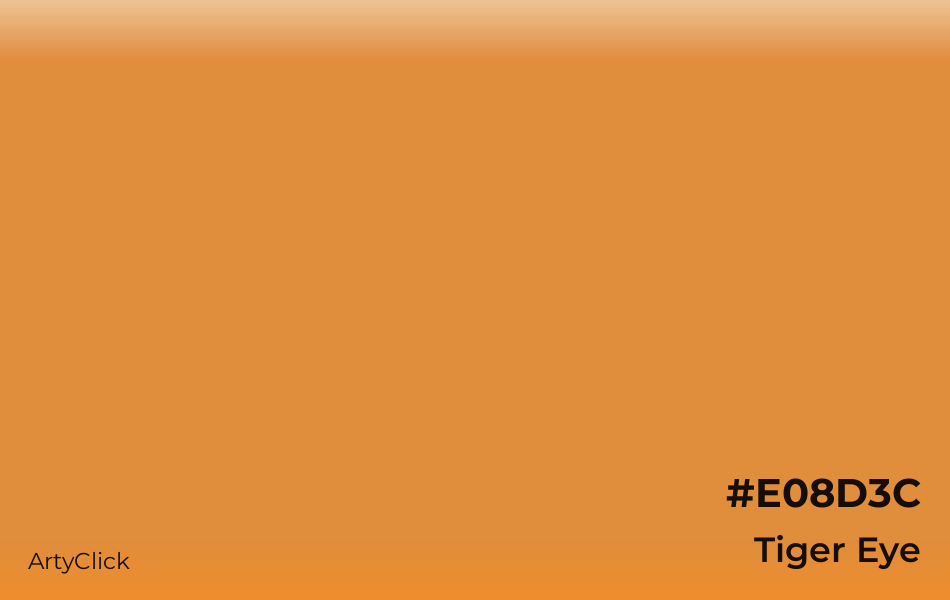Tiger Eye
#E08D3C

What color is Tiger Eye
Tiger Eye is a light bright shade of Orange. It belongs to the color family Orange, and it has high lightness and high saturation. Tiger Eye is a warm color.
What are the HEX, RGB, HSV, HSL and CMYK color codes of Tiger Eye
RGB space
CMYK space
The hex code for Tiger Eye is #E08D3C.
In the RGB (Red, Green, Blue) color space, which is used for digital colors, Tiger Eye has 88%% Red, 55% Green, and 24% Blue.
Tiger Eye has 30° Hue, 73% Saturation, and 88% Value in the HSV (Hue, Saturation, Value) color space, which is another way to represent digital colors.
Tiger Eye has 30° Hue, 73% Saturation, and 56% Lightness in the HSL (Hue, Saturation, Lightness) color space, which is a different way to express digital colors.
Tiger Eye has 0% cyan, 37% magenta, 73% yellow, and 12% black in the CMYK (Cyan, Magenta, Yellow, Black) color space, which is used for color printing.
Color Space |
Original Units |
Percentage |
|---|---|---|
Hex |
#E08D3C |
|
RGB |
(224, 141, 60) |
(88%, 55%, 24%) |
HSV |
(30°, 73, 88) |
(8%, 73%, 88%) |
HSL |
(30°, 73, 56) |
(8%, 73%, 56%) |
CMYK |
(0, 37, 73, 12) |
(0%, 37%, 73%, 12%) |
How does Tiger Eye contrast with black and white
The natural luminance of Tiger Eye is 35%, which is medium high.
Tiger Eye has a higher contrast with black than white.
Tiger Eye and black have a 8.0:1 contrast ratio, which meets the AAA requirement. These colors are suitable for text.
Tiger Eye and white have a 2.6:1 contrast ratio, which is insufficient for readability.
Luminance |
Contrast to Black |
Contrast to White |
|---|---|---|
35% |
AAA (8.0) |
insufficient (2.6) |
Example Black |
Example White |
Example Black |
Example White |
What colors go with Tiger Eye
How to mix Tiger Eye paint

To mix Tiger Eye paint using eight primary colors (Red, Green, Blue, Cyan, Magenta, Yellow, White, and Black), you'll need to combine 21% Yellow, 43% Red, 12% Black, 24% White, as shown below.

Yellow
21%

Red
43%

Green
0%

Blue
0%

Cyan
0%

Magenta
0%

Black
12%

White
24%
To mix Tiger Eye paint using five primary colors (Cyan, Magenta, Yellow, White, and Black), you'll need to combine 22% Magenta, 43% Yellow, 12% Black, 24% White, as shown below.

Cyan
0%

Magenta
22%

Yellow
43%

Black
12%

White
24%
What colors are similar to Tiger Eye
Colors similar to Tiger Eye are: Dull Orange, Dusty Orange, Cadmium Orange, Faded Orange, and Persian Orange. Dull Orange is darker than Tiger Eye. Dusty Orange is more red and brighter than Tiger Eye. Cadmium Orange is brighter than Tiger Eye. Faded Orange is more red and paler and lighter than Tiger Eye. Persian Orange is more red and paler than Tiger Eye.